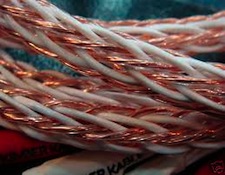It’s the time of year for saving money!

In theory a high-end cable should last forever. With a few
exceptions, cables don’t possess active parts that can wear out. Also, since
high-end cables are made with far more care, it stands to reason that fewer
would fail after time in the field due to cold-solder joints and other
manufacturing defects. But does a cable that’s say, fifteen years old, (yes, I
have quite a few that age) display any audible signs of deterioration in
performance over its “lifetime?
And what is a cable’s lifetime, anyway?
To find out the answers to these burning questions I went to
the sources – the heads of four cable manufacturers; Bill Low from AudioQuest,
Ray Kimber from Kimber Cable, Karen Sumner from Transparent Cable and David
Salz from WireWorld.

Ray Kimber said, “I posed that exact question at Audio Asylum
years ago, in the middle of a debate about cable break-on, a good discussion
followed. My thoughts are that a cable could deteriorate. The jacket could
degrade depending on the plastic used and the environment (UV exposure for
example), and the conductor could oxidize (such as if moisture was captured
under the jacket during extrusion). So,
there are lots of factors in that question.
Cable manufacturing has come a long way since its early days. One
major cable manufacturer used a water-permeable PVC jacket in one early version
of their cables, and after a couple of months the metal inside began to turn
green from exposure to high levels of humidity. Nowadays the best manufacturing
facilities are well aware of the hazards of humidity in the production process.”
A Cable’s useful life depends on many factors, not the least of
which is environmental. In a dry environment where they aren’t exposed to
physical abuse a cable can last a very long time.
Ray Kimber told me, “We have customers with cable from 1985
that’s been sent in for repair – usually it’s pets. Kimber has sold 1000’s of
miles of PBJ cable, which is a Teflon product, so unless mechanical trauma is
involved it could last hundreds of years!”

David Salz‘s take on the issue of cable aging was concise and
to the point, “My
position is that cables only have an expiration date if their design does not
adequately protect them from internal corrosion and breakdown due to bending
stress. High quality cables actually tend to improve with age as they continue
to break in as they are used.”
Karen
Sumner wrote, “Well-made cables oxidize relatively little over time. Find out
if your old cables are well made. Do they have impermeable, pressure-extruded
jackets and shiny, hard solder connections with high silver content solder that
seal the termination points? Do high-grade connectors cover the connections to
help prevent oxidation?
Severe oxidation
actually damages the crystalline structure of the conductors, and there were
some designs that employed termination techniques that changed the integrity of
the conductors from the start. It’s a condition that only worsens over time.
I’ve seen old cables with Litz conductors where the strands have turned black
and flake and crumble apart as far as a foot up the cable!
If
someone has old cables with lacquer-coated conductors in them, replace them if
there is any visible oxidation. Audio equipment archivists should be aware that
quite a few audiophile cable brands from a decade or so ago used some sort of
Litz-conductor construction. If your old cables do not have any lacquer-coated
conductors and they are well made, then enjoy them totally until you are ready
to upgrade them for newer technology and more performance.”

Bill
Lowe summed up, “As for degradation over time, there is one main area of
vulnerability – cables with multiple bare-copper strands touching. While
silver-oxides and tin-oxides are conductive, copper oxides are semi-conductors.
This means that the conductivity of the connection between strands varies with
signal amplitude. It’s a dynamic distortion mechanism. Depending on the
particular insulation used, this can be an essentially theoretical
vulnerability, or one guaranteed to cause degradation over time.
There
are always the freak things that might go wrong on rare occasions, however
corrosion of bare-copper strands and the resulting increased distortion at the
strand interface is to me the only predictable source of long term degradation
in cables.”






“Cable break-in” HAHAHAHAHAHAHAHA!